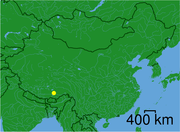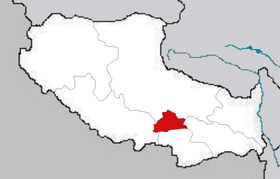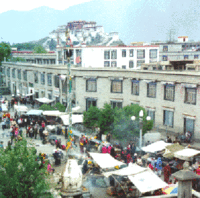Lhasa
2007 Schools Wikipedia Selection. Related subjects: Geography of Asia
Lhasa ( Tibetan: ལྷ་ས་; Wylie: lha-sa; Simplified Chinese: 拉萨; Traditional Chinese: 拉薩; pinyin: Lāsà), sometimes spelled Llasa, is the traditional capital of Tibet and the capital of the Tibet Autonomous Region of the People's Republic of China. It is also the traditional seat of the Dalai Lama.
Lhasa literally means "place of the gods", although ancient Tibetan documents and inscriptions demonstrate that the place was first called Rasa, which means "courtyard place" or "goat place". Its altitude is about 3,650 m (12,000 ft), making it one of the highest cities in the world. The city is home to about 200,000 inhabitants.
Administration
Administratively speaking, Lhasa is a prefecture-level city that consists of one district and seven counties. The district comprises the urban area of Lhasa and is called Chengguan District (Tibetan: ཁྲིན་ཀོན་ཆུས་, Wylie: khrin kon chus, Simplified Chinese: 城关区; Traditional Chinese: 城關區; pinyin: Chéngguān Qū). The seven counties are Lhünzhub, Damxung, Nyêmo, Qüxü, Doilungdêqên, Dagzê, and Maizhokunggar.
History
Legend has it that the second Tibetan emperor Songtsen Gampo made Lhasa his capital. But contemporary documents (e.g. The Old Tibetan Annals) show that the empire was ruled from a moving capital.
The city rose to prominence following the founding of three large Gelugpa monasteries by Je Tsongkhapa and his disciples in the 15th century. The three monasteries are Ganden, Sera, and Drepung monasteries.
The fifth Dalai Lama, Lobsang Gyatso ( 1617– 1682), conquered Tibet and moved the centre of his administration to Lhasa. There, he started constructing the Potala Palace, which was finished some years after his death. During this time, Lhasa gained its unquestioned status as the political capital of Tibet.
In the first half of the 20th century, several western explorers made celebrated journeys to the city, including Francis Younghusband, Alexandra David-Néel, and Heinrich Harrer. Lhasa was the centre of Tibetan Buddhism, and nearly half of its population were monks. The population of Lhasa was estimated at 25,000 in 1951, excluding some 15,000 monks in area's monasteries. As of the early 2000s, the city's population stands at about 250,000. For the history of Tibet since 1950, see the history of Tibet.
Geography


Lhasa lies at in an area known as the " Lhasa Valley"; even though the average altitude of the valley is well over 3,000 m (10,000 ft) the mountains around it rise to 5,500 m (18,000 ft). The Kyi (or Kyi Chu) River, a tributary of the Brahmaputra River, runs through the city.
Depending on how the status of Tibet before 1950 is interpreted, Lhasa can be regarded as the highest national capital at that time, surpassing La Paz, Bolivia, which currently holds that distinction.
Economy
The tourism industry now brings significant business to the region, building on the attractiveness of the Potala Palace, the spectacular Himalayan landscape, and the many wild plants and animals native to the high altitudes of Central Asia. Many of Lhasa's rural residents practice traditional agriculture and animal husbandry. Lhasa is also the traditional and current hub of the Tibetan trading network. For many years, chemical and automobile plants operated in the area, because the city's remoteness allowed them to pollute with minimal restriction. However, this has changed in recent years. Copper, lead, and zinc are mined nearby, and the Chinese government is experimenting with new methods of mineral mining and ground heat extraction in the area.
Demographics
The total population of Lhasa Prefecture-level City is 521,500 (including known migrant population, excluding military garrisons). Of this, 257,400 are in the urban area (including migrant population of 100,700), while 264,100 are outside. Nearly half of Lhasa Prefecture-level City's population lives in Chengguan District, which is the administrative division that contains the urban area of Lhasa (i.e. the actual city).
According to the 2000 census, the ethnic distribution in Lhasa Prefecture-level City was as follows in November 2000:
| Major ethnic groups in Lhasa Prefecture-level City by district or county, 2000 census | |||||||
|---|---|---|---|---|---|---|---|
| Total | Tibetans | Han Chinese | others | ||||
| Lhasa Prefecture-level City | 474,499 | 387,124 | 81.6% | 80,584 | 17.0% | 6,791 | 1.4% |
| Chengguan District | 223,001 | 140,387 | 63.0% | 76,581 | 34.3% | 6,033 | 2.7% |
| Lhünzhub County | 50,895 | 50,335 | 98.9% | 419 | 0.8% | 141 | 0.3% |
| Damxung County | 39,169 | 38,689 | 98.8% | 347 | 0.9% | 133 | 0.3% |
| Nyêmo County | 27,375 | 27,138 | 99.1% | 191 | 0.7% | 46 | 0.2% |
| Qüxü County | 29,690 | 28,891 | 97.3% | 746 | 2.5% | 53 | 0.2% |
| Doilungdêqên County | 40,543 | 38,455 | 94.8% | 1,868 | 4.6% | 220 | 0.5% |
| Dagzê County | 24,906 | 24,662 | 99.0% | 212 | 0.9% | 32 | 0.1% |
| Maizhokunggar County | 38,920 | 38,567 | 99.1% | 220 | 0.6% | 133 | 0.3% |
Excludes members of the People's Liberation Army in active service.
Source: Department of Population, Social, Science and Technology Statistics of the National Bureau of Statistics of China (国家统计局人口和社会科技统计司) and Department of Economic Development of the State Ethnic Affairs Commission of China (国家民族事务委员会经济发展司), eds. Tabulation on Nationalities of 2000 Population Census of China (《2000年人口普查中国民族人口资料》). 2 vols. Beijing: Nationalities Publishing House (民族出版社), 2003. ( ISBN 7-105-05425-5)
The Tibetan government in exile and other Tibetan groups say that, if the excluded PLA garrisons and migrants from outside Tibet are considered, ethnic Tibetans are now the minority in Lhasa.
Due to the partial liberalization of the economy over the past decade, greater freedom of movement and various government incentives, thousands of Han Chinese from China proper have settled in the area, and play a large part in Lhasa's economy.
Culture
Lhasa has many historic relics, including the Potala Palace, Jokhang Temple, Sera Monastery, Zhefeng Temple, Drepung Monastery and Norbulingka. However, many important sites were damaged or destroyed during the Cultural Revolution.
The city of Lhasa contains three concentric paths used by pilgrims to circumambulate (walk around) the sacred Johkhang Temple, many of whom make full or partial prostrations along these routes in order to gain spiritual merit. The innermost, the Nangkor (Nang-skor), is contained within the Jokhang temple, and surrounds the sanctuary of the Jowo Shakyamuni, the most sacred statue in Tibetan Buddhism. The middle circumambulatory, the Barkor (Bar-skor), passes through the old town and surrounds the Jokhang temple and various other buildings in its vicinity. The outer Lingkor (Gling-skor) encircles the entire traditional city of Lhasa. Due to the construction of a large new street, Beijing Lam, the Lingkor is not usually used by pilgrims today.
Tourism
According to the region's authorities, 1.1 million visitors visited Tibet in 2004. Chinese authorities plan an ambitious growth of tourism in the region to 10 million visitors by 2020; these visitors are expected to be mostly ethnic Chinese. Proponents of greater Tibetan autonomy are concerned that the increase in tourism will lead to an erosion of the indigenous culture of Tibet; in particular, these proponents have stated that renovation around historic sites, such as the Potala Palace, a UNESCO World Heritage Site, are creating a jarring "Disney-like" degradation of the sacred site.
Journalists report that the opening of the railway in July 2006 has brought with it an increasing demand for property which has pushed prices up.
Three trains arrive in and depart from Lhasa railway station each day. Train numbered T27 takes 47 hours, 28 minutes from Beijing west, arrives in Lhasa at 20:58 every day. The ticket costs 389 yuan for hard seat, or 813 yuan for a lower hard sleeper, 1262 yuan for a lower soft sleeper. T28 from Lhasa to Beijing west departs at 08:00 and arrives in Beijing at 08:00 on the third day, taking 48 hours. There are also trains from Chengdu, Chongqing, Lanzhou and Xining. Initially the large altitude difference has caused problems on this route, giving passengers altitude sickness. To counter this, extra oxygen is pumped in through the ventilation system, and personal oxygen masks are available.
Lhasa Airport is located about 98 kilometres (61 miles) south of the city.
Lhasa in entertainment
Life in Lhasa was covered by Austrian mountaineer Heinrich Harrer in his book Seven Years In Tibet and the film of that same name which starred Brad Pitt and David Thewlis. The book in particular relates to life in Lhasa during the 1940s.





